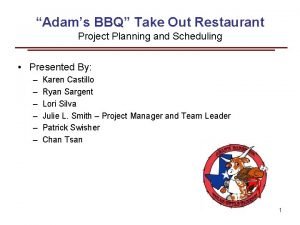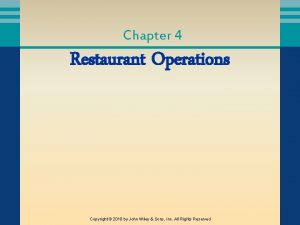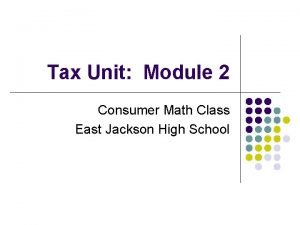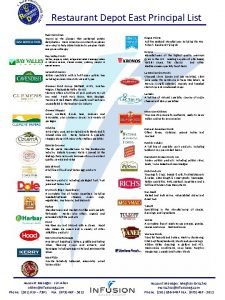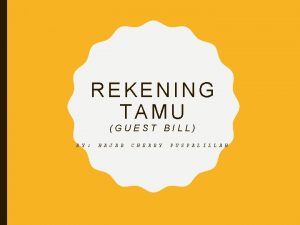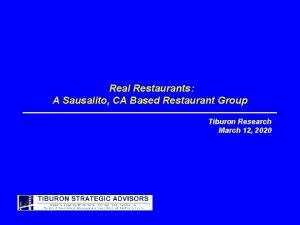Marias Restaurant Chapter 1 Section 5 Marias Restaurant
























- Slides: 24

Maria’s Restaurant Chapter 1 Section 5

Maria’s Restaurant Location What If Maria’s Restaurant was picked up and dropped in Detroit MI, San Antonio TX, or Denver CO?

Zone 1 In Detroit MI

Zone 1 In Detroit MI The heating load requirement has more than doubled from 34, 384 Btuh to 85, 261 Btuh for Zone 1, and the cooling load requirement has actually gone up slightly from 71, 666 Btuh to 86, 050 Btuh.

Zone 2 In Detroit MI

Zone 2 In Detroit MI is very different from the load in Long Beach CA, the heating load requirement has more than doubled from 111, 764 Btuh to 277, 828 Btuh for Zone 2, and the cooling load requirement has actually more than doubled too, going from 115, 534 Btuh to 241, 221 Btuh.

Zone 1 In San Antonio TX

Zone 1 In San Antonio TX The load for San Antonio TX is again very different from the load in Long Beach CA. Our heating load requirement went up from our 34, 384 Btuh to 52, 038 Btuh for Zone 1, and our cooling load requirement went up from 71, 666 Btuh to 91, 464 Btuh.

Zone 2 In San Antonio TX

Zone 2 In San Antonio TX Load totals for San Antonio TX are very different from the load totals in Long Beach CA, the heating load requirement rose from 111, 764 Btuh to 168, 577 Btuh for Zone 2, and the cooling load requirement has actually more than doubled too, going from 115, 534 Btuh to 258, 492 Btuh.

Zone 1 In Denver CO

Zone 1 In Denver CO The load for Denver CO is again very different from the load in Long Beach CA, the heating load requirement more than doubled again, going from our 34, 384 Btuh to 83, 208 Btuh for Zone 1, and the cooling load requirement went down slightly from 71, 666 Btuh to 69, 376 Btuh.

Zone 2 In Denver CO

Zone 2 In Denver CO has a very different load than the one we had in Long Beach CA, the heating load requirement more than doubled from 111, 764 Btuh to 261, 557 Btuh for Zone 2, and the cooling load requirement has decreased, going from 115, 534 Btuh to 106, 589 Btuh.

Comparison Graph

Comparison Graph Calculations Based on an estimate using the graph, what would the total heating in Btuh be for the location that requires the most heat?

Comparison Graph Calculations Detroit MI beat out Denver with approximately 360, 000 Btuh shown on the graph. Note: We know the exact total is Zone 1 + Zone 2 from our table values, or 277, 828 + 85, 261 = 363, 089 Btuh

Graph Calculations Based on an estimate using the graph, what would the Sensible Cooling load be for Long Beach CA?

Graph Calculations Sensible Cooling Based on an estimate using the graph, Long Beach CA has a Total Cooling Load of 190, 000 Btuh and a Latent Cooling Load of about 40, 000 Btuh. Total Cooling = Sensible Cooling + Latent Cooling Thus: 190, 000 Btuh = Sensible Cooling + 40, 000 Btuh Sensible Cooling =150, 000 Btuh

Super Heat Ratio A comparison number for evaluating how much humidity removal is required for cooling called Super Heat Ratio (SHR) is used in the equipment selection process. SHR = Sensible Cooling ÷ Total Cooling Load Using the table values find the SHR for San Antonio TX.

Graph Calculations Based on an estimate using the graph, what would the Super Heat Ration be for San Antonio TX?

SHR First find the Sensible Cooling Total 350, 000 Btuh = Total Cooling 100, 000 Btuh = Latent Cooling Thus, 350, 000 – 100, 000 = Sensible Cooling = 250, 000

SHR Second find the SHR = Sensible Cooling ÷ Total Cooling Load 350, 000 Btuh = Total Cooling 100, 000 Btuh = Latent Cooling 250, 000 Btuh = Sensible Cooling Thus, SHR = 250, 000 ÷ 350, 000 = 0. 714 (Note: More on SHR in Chapter 2)

Field Notes Numerous attempts to tune an HVAC system were made for a building in North Carolina with a new maintenance contract. The HVAC contractor wanted to know what the solution was for this building. A top diagnostic technician was sent to a location where the building was not cooling properly. While there, the technician found a Manual N load calculation was done for the equipment sizing. After studying the Load calculation the problem was clear: Undersized equipment, the wrong weather data was used. The load calculation had Dayton Ohio selected as the building’s location!
 Michael marias
Michael marias O sentimento dum ocidental ave marias
O sentimento dum ocidental ave marias Marias vuggevise
Marias vuggevise Adams bbq
Adams bbq Concept mapping chapter 10 meiosis 1 and meiosis 2
Concept mapping chapter 10 meiosis 1 and meiosis 2 Chapter 7 restaurant
Chapter 7 restaurant Chapter 4 restaurant
Chapter 4 restaurant Section b reservation
Section b reservation Revolved section
Revolved section What is a revolved section view? a revolved section view:
What is a revolved section view? a revolved section view: Half section view
Half section view Work and energy section 2 describing energy answer key
Work and energy section 2 describing energy answer key Restaurant kasterlinden
Restaurant kasterlinden Restaurant nessa bacau
Restaurant nessa bacau Devil island prison restaurant
Devil island prison restaurant Tips earned by a server in a fashionable restaurant
Tips earned by a server in a fashionable restaurant Sequence diagram for restaurant management system
Sequence diagram for restaurant management system Dna replication
Dna replication Restaurant module
Restaurant module Sample banquet event order
Sample banquet event order Restaurant management system (rms)
Restaurant management system (rms) Restaurant depot clams
Restaurant depot clams Service sequence in a restaurant
Service sequence in a restaurant Manfaat guest bill bagi tamu hotel adalah
Manfaat guest bill bagi tamu hotel adalah Real restaurants
Real restaurants



